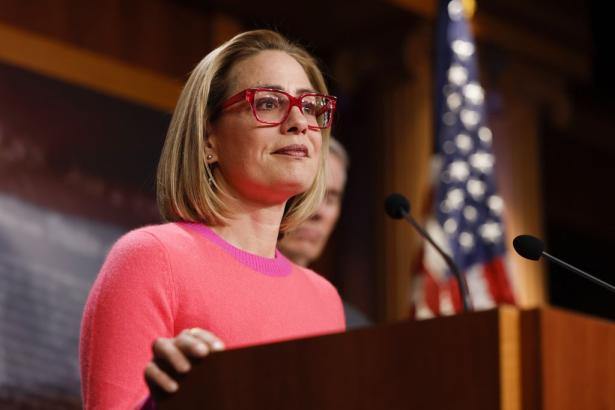Arizona Senator Kyrsten Sinema’s announcement Friday that she’s leaving the Democratic Party to become an independent caught many by surprise, but perhaps it shouldn’t have.
Interviews with Politico and CNN, along with a slickly produced video explaining her move, make clear this was not a hurried decision.
Sinema’s switch is at once politically expedient and entirely consistent with her ever-changing political career, one that began with the Green Party, veered to a first run as an independent, shifted to the Democrats, and has now apparently circled back to independence.
When Sinema told CNN Friday that “I’ve never fit neatly into any party box,” she wasn’t wrong. The question is, why the change of party affiliation now? And what does that mean for Democrats, who, with Senator Raphael Warnock’s runoff win Tuesday in Georgia, had achieved a bit of breathing room with a 51-49 majority in the Senate?
Here’s what we know
The most important part of Sinema’s announcement is that she isn’t disrupting the balance of power in the Senate. She says she will still vote with Democrats, though like Vermont’s Bernie Sanders and Maine’s Angus King, she will be an independent. She will still vote to make Democrat Chuck Schumer the Senate majority leader. And indeed, she told Politico she expects to keep a pair of subcommittee chair roles, as a member of the majority coalition would.
The only things that will change don’t matter all that much. Sure, it takes away some of the jubilation Democrats have had in recent weeks after stronger-than-expected midterms. And Sinema said she won’t attend the weekly Senate Democratic strategy sessions, but she rarely went to those anyway.
But we also know this: Sinema is pretty clearly running for reelection in two years. While in the CNN and Politico interviews she said reelection is not something she’s thinking about now, she’s obviously doing just that.
Her new video looks very much like a reelection launch — down to her purple outfit. (Get it?) And that’s not surprising. In recent days, Arizona Representative Ruben Gallego has made it clear he was gearing up to run against her in the Democratic primary.
And Sinema sees the same polls voters do. A recent one, from respected pollsters hired by AARP this fall, shows just how deeply unpopular she lately is in her home state. Overall, she has just a 37 percent approval rating, with 54 percent of respondents disapproving. That is, as pollsters call it, a net -17. Among Democrats, she was -20, a rough sign for her Democratic primary chances.
At the same time, she is -18 among Republicans. And considering that Arizona Republicans just nominated MAGA types Kari Lake and Blake Masters in contested statewide primaries, it’s impossible to see how Sinema could become a Republican nominee. (By the way, the same poll found Sinema as unpopular among independents as she was among every other demographic, from age to race to gender to education level.)
In other words, Sinema needed to shake things up ahead of a reelection run.
Why now?
Beyond the need to recast her campaign narrative, Sinema likely had two other reasons for making the announcement now.
First is that Tuesday’s win in the Georgia Senate runoff made the timing of her party switch more palatable than if she’d done it before, potentially raising the stakes of that contest. Sinema told Politico she was “delighted” that Warnock, the Democratic incumbent, won that race.
Second is that she is arguably trying to woo Republicans more than she ever has in her political career. Just weeks ago, Sinema announced she’s working on a comprehensive immigration bill with Republican Senator Thom Tillis of North Carolina. The pair are hoping to pass the bill this month, before Republicans take over the House, making it significantly harder to pull off.
For now, it remains unclear where support for the bill stands, and if it can achieve the 60 votes necessary to move on it in the Senate. Democrats will likely be on board, but the pair will need to peel off nine Republicans. Maybe this move from Sinema entices some Republicans to play along. Frankly, though, the Senate already has a lot on its plate this month, including passing a major budget bill.
What we don’t know
While a lot is known about the short term, Sinema’s situation gets more unpredictable in the long term.
She has ruled out running for president in 2024, so that’s off the table. But her 2024 campaign is especially hard to figure out. Does a three-way general election with a Republican nominee, Democratic nominee, and an independent Sinema make it more or less likely that a Republican wins? On one level, if Sinema had made it through a Democratic primary, the Democrats would likely be in a better spot to beat a Republican. But Sinema getting through the primary would have been a big if.


Spread the word